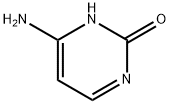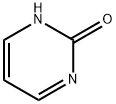Cytosine , 10mMinDMSO , 71-30-7
Synonym(s):
4-Amino-2-hydroxypyrimidine;4-Aminopyrimidin-2-(1H)-one;Cytosine
CAS NO.:71-30-7
Empirical Formula: C4H5N3O
Molecular Weight: 111.1
MDL number: MFCD00006034
EINECS: 200-749-5
| Pack Size | Price | Stock | Quantity |
| 1ml | RMB159.20 | In Stock |
|
| others | Enquire |
PRODUCT Properties
| Melting point: | >300 °C (lit.) |
| Boiling point: | 208.2°C (rough estimate) |
| Density | 0,48 g/cm3 |
| refractive index | 1.5000 (estimate) |
| storage temp. | 2-8°C |
| solubility | Clear to very slightly hazy colorless to faint yellow solution at 50 mg/ml in 0.5 M HCL. |
| form | Crystalline Powder |
| pka | 4.60, 12.16(at 25℃) |
| color | White to slightly yellow |
| biological source | synthetic (organic) |
| Water Solubility | soluble |
| Merck | 14,2795 |
| BRN | 2637 |
| Stability: | Stable. Incompatible with strong oxidizing agents. |
| InChIKey | OPTASPLRGRRNAP-UHFFFAOYSA-N |
| LogP | -1.962 (est) |
| CAS DataBase Reference | 71-30-7(CAS DataBase Reference) |
| NIST Chemistry Reference | 2(1H)-Pyrimidinone, 4-amino-(71-30-7) |
| EPA Substance Registry System | 2(1H)-Pyrimidinone, 4-amino- (71-30-7) |
Description and Uses
Cytosine is pyrimidine; along with adenine and guanine they account for the fi ve nucleic acid bases. Pyrimidines are heterocyclic single-ringed compounds based on the structure of pyrimidine. Cytosinelike adenine and guanine, form nucleosides and nucleotides in RNA and DNA. When the bases combine with ribose, a ribonucleoside forms; and when it attaches to deoxyribose, a deoxyribosenucleoside is formed. Names of the nucleoside are summarized in Table 29.1.these in turn combine with phosphoryl groups, in a process called phosphorylation, to form their respective nucleotides that form nucleic acids.the nucleotides can be tri, di, and mono phosphate nucleotides similar to the way in which adenine forms ATP, ADP, and AMP.
Widely distributed in nature; constituent of nucleic acids
Safety
| Symbol(GHS) |  GHS07 |
| Signal word | Warning |
| Hazard statements | H315-H319-H335 |
| Precautionary statements | P305+P351+P338 |
| Hazard Codes | Xi,Xn |
| Risk Statements | 36/37/38-20/21/22 |
| Safety Statements | 26-36-37/39 |
| WGK Germany | 1 |
| RTECS | UW7350150 |
| Hazard Note | Irritant |
| TSCA | Yes |
| HS Code | 29335910 |




